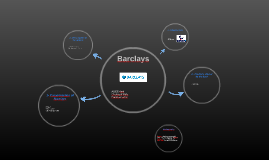Barclays
Transcript: Introduction Aisha Emara 1642008 Ramgopal Selvaraj 1657052 David Jaros 1441236 The Team Barclays in the UK Background UK economy Industry analysis Financial analysis Forecast Background Background Founded in 1690 120 Thousand Employees Europe USA Africa Asia Products and Services: -Personal banking services - Credit cards and transactional lending - Investment products and services - Business banking solutions Economic analysis Interest rates and inflation UK economy Consumers UK economy Service UK economy Banks UK economy Industry analysis Buyer Power PORTER 5 FORCES Competiton New Entrants Substitution Supplier Power Competitive Environment External Factors Technology Political Environment - Digital Age: Mobile and Internet Banking - Rapid Technological Innovations: Open Banking Block-Chain Aritifical Intelligence - Growth in Cyber-Fraud - Increase in geopolitical tensions - Post-Brexit arrangements Post the 2007-2009 financial crisis there has been number of regulatory reforms implemented by Central Banks all over the world to prevent such crisis in the future and UK's FCA and PRA has also implemented many regulations to the financial industry its operating. Some of them were, Financial Services and Markets Act 2000 (as amended) (FSMA) CRD IV, which implements Basel III, the main primary source for capital, liquidity and leverage requirements in the EEA. Market Abuse Regulation. European Market Infrastructure Regulation. Short Selling Regulation. Securities Financing Transactions Regulation. Markets in Financial Instruments Regulation (MiFIR) (from 2018). Benchmarks Regulation. This may expected to change significantly over the next few years. Since in June 2016, the UK voted in favour of leaving the European Union, which is expected to have an impact on the legal and regulatory framework governing the regulation of banks in the UK Government Regulations Financial Analysis Financial Analysis Income statement Financial Ratios BVPS and CPS Forecasts Forecasts The 17 analysts offering 12 month price targets for Barclays PLC have a median target of 230.00, with a high estimate of 252.00 and a low estimate of 150.00. The median estimate represents a 11.00% increase from the last price of 207.20 Share price forecast Dividends In 2017, Barclays PLC reported a dividend of 0.03 GBP, equaling last years dividend. The 18 analysts covering the company expect dividends of 0.06 GBP for the upcoming fiscal year, an increase of 103.33% Earnings history & estimates Barclays PLC reported 4th quarter 2017 earnings of 0.0255 per share. This result was in line with the expectation of the one analyst following the company and under-performed last year's 4th quarter results by 36.25%. The next earnings announcement is expected on Apr 26, 2018 Barclays PLC reported annual 2017 earnings of 0.1492 per share on Feb 22, 2018 Revenue history & estimates Barclays PLC had 4th quarter 2017 revenues of 5.02bn. This missed the 5.16bn consensus estimate of the 6 analysts following the company. This was 0.60% above the prior year's 4th quarter results Barclays PLC had revenues for the full year 2017 of 21.08bn. This was 1.75% below the previous year's results. Contact Contact Info Aisha Emara w1642008@my.westminster.ac.uk Ramgopal Selvaraj w1657052@my.westminster.ac.uk David Jaros w1441236@my.westminster.ac.uk Q & A

















